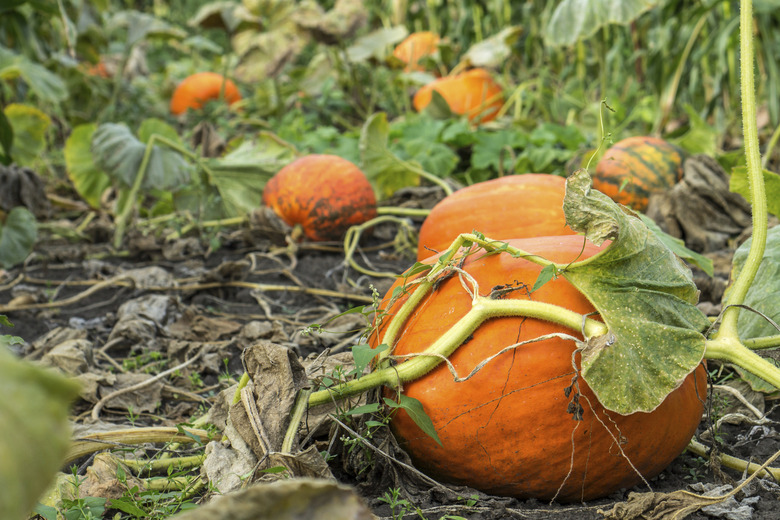Yellow Leaves On A Pumpkin
When growing pumpkins (Cucurbita maxima varieties) in the home garden, the sight of yellowing leaves can jar gardeners used to enjoying sprawling green foliage and deep orange fruit on these annual vines. Yellowing leaves signal something amiss with your pumpkin crop, and can be caused by several different factors. Prompt action and the right diagnosis can help you limit damage to your pumpkins and get your harvest back on track.
Step 1
Appropriate care for your pumpkin vines is essential to a good crop and green leaves. Healthy pumpkins have a greater likelihood of avoiding and recovering from pest and disease issues that affect these well-known squash. Grow pumpkin vines in areas that provide full sunlight for best development. Maintain moist, well-drained soil with pH levels between 6.2 and 6.5 for best growth. Pumpkins need irrigation, though overhead watering can contribute to problems with fungal disease. Water soil directly through methods like drip irrigation. Irrigate to a depth of 6 inches for moist, but not saturated, soil.
Step 2
- Appropriate care for your pumpkin vines is essential to a good crop and green leaves.
- Pumpkins need irrigation, though overhead watering can contribute to problems with fungal disease.
Balancing Nutrition
Step 1
When care is under control, nutrient deficiency may be behind yellow pumpkin leaves. Even when compost is generously mixed in the garden before planting, pumpkins often need extra nitrogen. Incorporate compost or a 5-10-10 granular fertilizer at planting at a rate of 1 to 2 tablespoons per plant. One week after pumpkins blossom, add a high-nitrogen fertilizer such as 33-0-0 ammonium nitrate at the rate of 1 tablespoon per plant. Repeat that application again in three weeks. Wear gloves and safety goggles when working with chemicals, and water the area well after your applications. A soil test helps confirm any other possible nutrient problems.
Step 2
- When care is under control, nutrient deficiency may be behind yellow pumpkin leaves.
- One week after pumpkins blossom, add a high-nitrogen fertilizer such as 33-0-0 ammonium nitrate at the rate of 1 tablespoon per plant.
Managing Mildew
Step 1
Powdery mildew is a common pumpkin disease caused by fungal infections. During warm weather, powdery mildew starts with yellow leaf spots that grow into yellowed, dying leaves. A powderlike fuzzy growth also develops on leaves, as the name suggests. To prevent powdery mildew on pumpkins, keep the area surrounding your pumpkins free of weeds, and avoid overhead irrigation. Water in the mornings, so leaves dry by nightfall. Never work with your pumpkins when foliage is wet, and keep all equipment sterilized with household disinfectant to prevent disease spread. If mildew is severe, apply a ready-to-use horticultural oil spray to control further spread. Never use oils on drought-stressed pumpkins or with temperatures above 90 degrees Fahrenheit.
Step 2
- Powdery mildew is a common pumpkin disease caused by fungal infections.
- Never work with your pumpkins when foliage is wet, and keep all equipment sterilized with household disinfectant to prevent disease spread.
Beating Borers
Step 1
Squash vine borers attack pumpkins with the potential for severe damage. Wreaking havoc as cream-hued, brown-headed larvae measuring approximately 1 inch in length, these pests bore into pumpkin vines. Boring inhibits the water and nutrient distribution throughout the plant, leading to wilting, yellowed leaves and plant death. Prevention and intervention are key to control. Cover pumpkin plants with row covers as soon as you notice squash borer activity. If you've had past problems, do it right after planting. Destroy all affected vines and plants and dispose of the infected debris. Plant pumpkins in different areas each year. A ready-to-use pyrethrum spray can help control damage. Spray leaves thoroughly so the pests contact the spray.
Step 2
- Squash vine borers attack pumpkins with the potential for severe damage.
References
- University of California IPM Online: Powdery Mildew — Sphaerotheca Fuliginea and Erysiphe Cichoracearum
- North Dakota State University Agriculture: Disease Management In Home-Grown Cucumbers, Melons and Squash
- University of Illinois Extension: Pumpkins (Vegetables & Fruits)
- Clemson University Extension: Cucumber, Squash, Melon & Other Cucurbit Insect Pests
- Clemson University Extension: Pumpkins & Winter Squash
- University of Minnesota Extension; Squash Vine Borer Management in Home Gardens; Jeffrey Hahn, et al.
